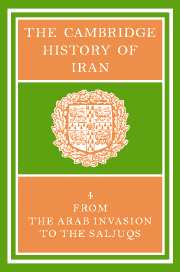Book contents
- Frontmatter
- 1 THE ARAB CONQUEST OF IRAN AND ITS AFTERMATH
- 2 THE ‘ABBĀSID CALIPHATE IN IRAN
- 3 THE ṬĀHIRIDS AND ṢAFFĀRIDS
- 4 The SĀMĀNIDS
- 5 THE EARLY GHAZNAVIDS
- 6 THE MINOR DYNASTIES OF NORTHERN IRAN
- 7 IRAN UNDER THE BŪYIDS
- 8 TRIBES, CITIES AND SOCIAL ORGANIZATION
- 9 THE VISUAL ARTS
- 10 NUMISMATICS
- 11 THE EXACT SCIENCES
- 12 LIFE SCIENCES, ALCHEMY AND MEDICINE
- 13(a) PHILOSOPHY AND COSMOLOGY
- (b) SŪFISM
- 14 THE RELIGIOUS SCIENCES
- 15 SECTS AND HERESIES
- 16 NĀSIR-I KHUSRAU AND IRANIAN ISMĀ‘ĪLĪSM
- 17 ZOROASTRIAN LITERATURE AFTER THE MUSLIM CONQUEST
- 18 ARABIC LITERATURE IN IRAN
- 19 THE RISE OF THE NEW PERSIAN LANGUAGE
- 20 (a) THE “RUBĀ'Ī” IN EARLY PERSIAN LITERATURE
- (b) ‘UMAR KHAYYĀM: ASTRONOMER, MATHEMATICIAN AND POET
- Bibliography
- Index
- Plate section
- Plate section">
- Map 1. Iran under the Abbasids">
- References
18 - ARABIC LITERATURE IN IRAN
Published online by Cambridge University Press: 28 March 2008
- Frontmatter
- 1 THE ARAB CONQUEST OF IRAN AND ITS AFTERMATH
- 2 THE ‘ABBĀSID CALIPHATE IN IRAN
- 3 THE ṬĀHIRIDS AND ṢAFFĀRIDS
- 4 The SĀMĀNIDS
- 5 THE EARLY GHAZNAVIDS
- 6 THE MINOR DYNASTIES OF NORTHERN IRAN
- 7 IRAN UNDER THE BŪYIDS
- 8 TRIBES, CITIES AND SOCIAL ORGANIZATION
- 9 THE VISUAL ARTS
- 10 NUMISMATICS
- 11 THE EXACT SCIENCES
- 12 LIFE SCIENCES, ALCHEMY AND MEDICINE
- 13(a) PHILOSOPHY AND COSMOLOGY
- (b) SŪFISM
- 14 THE RELIGIOUS SCIENCES
- 15 SECTS AND HERESIES
- 16 NĀSIR-I KHUSRAU AND IRANIAN ISMĀ‘ĪLĪSM
- 17 ZOROASTRIAN LITERATURE AFTER THE MUSLIM CONQUEST
- 18 ARABIC LITERATURE IN IRAN
- 19 THE RISE OF THE NEW PERSIAN LANGUAGE
- 20 (a) THE “RUBĀ'Ī” IN EARLY PERSIAN LITERATURE
- (b) ‘UMAR KHAYYĀM: ASTRONOMER, MATHEMATICIAN AND POET
- Bibliography
- Index
- Plate section
- Plate section">
- Map 1. Iran under the Abbasids">
- References
Summary
THE UMAYYAD AGE IN IRAN
Although Arabic literature in Iran can be traced from the 1st/7th century onwards, it is nevertheless true that for the first two centuries or so the sources available are scanty and widely dispersed in later works. But this is a problem affecting all Arabic literature in the early period of Islam. Another obstacle is that at the outset little attention was paid to the Iranian part of the Muslim world, for the centre of the stage was held by the pace-setters in the Hijāz at first, then later in Damascus and Baghdad. This was due in large part to the origins of Islam in the Hijāz and to the subsequent displacements of its capital and the consequent downgrading of cultural centres elsewhere in Iran to the east or in Africa and Spain to the west.
As for Iran in particular, the rôle of Persians in Arabic literature could hardly be over-emphasized. Arabic literature ceased to be the exclusive property of the Arabs after the 1st/7th century, and it is most unjust and hardly objective to compile histories of Arabic literature that give the impression that somehow all the great authors were Arabs; but this is precisely the case ever since modernist Arab nationalists have taken to composing histories of Arabic literature, not to mention their histories of Islamic civilization.
If the Persians played more than just a passive rôlo in Arabic literature, and even in the greater formulation of Islamic traditional culture, this is in great measure because the entire extent, and not merely a part, of the ancient Sāsāian empire, with all of its institutions and cultural traditions, fell to the lot of the Arab conquerors.
Keywords
- Type
- Chapter
- Information
- The Cambridge History of Iran , pp. 566 - 594Publisher: Cambridge University PressPrint publication year: 1975
References
- 3
- Cited by

